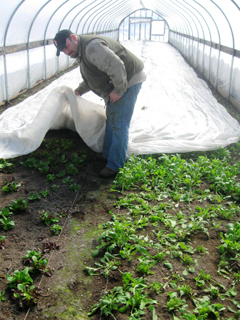Written by Liz Barbour.
 The air is crisp, the fruit trees are bare, and the strawberry patch is blanketed with snow. Winter is here and you might think your local farmer is taking a much deserved break from the hard work of the previous season. Think again.
The air is crisp, the fruit trees are bare, and the strawberry patch is blanketed with snow. Winter is here and you might think your local farmer is taking a much deserved break from the hard work of the previous season. Think again.
The winter months are extremely busy for local farmers as plans are made for the next season’s crops.
The creative work of crop planning starts in January and February as complex seed orders are worked out, a task requiring a planting plan for the entire year ahead. Farmers study the previous year’s sales trends, and expense reports trying to determine how to execute next year’s crop rotations, staffing schedule, machine maintenance, harvest plans, and distribution goals, while meeting the demands of farm stand clientele and wholesale customers looking for locally grown food and seedling stocks. And no farmer can do any planning without considering the weather and what Mother Nature can throw at the farm as the seasons move ahead.
In addition to seed purchases, January and February are the time for dormant apple and peach trees to receive their yearly pruning. Fruit trees are pruned now to open the tree structure and allow increased sun exposure and air circulation throughout the growing season. This promotes bud and fruit growth, and is also critical to disease prevention and insect control, helping to reduce the need for pesticides. Following the pruning, brush piles are burned to eliminate contaminated material.
Speaking of apples, at local farms such as Brookdale Fruit Farm in Hollis, the months of March and April mark the distribution of the last of the stored apples from the previous fall’s harvest. As the apples were harvested in the autumn months, they were stored in large controlled atmosphere coolers called CA rooms. These large coolers, which can be the size of half a basketball court, carefully store the apples in a low oxygen environment so that the natural sugars in the apples turn to starches and store like potatoes. But, when the doors are opened and the oxygen returns to the apples, the starches convert back to sugars. So, we can continue to eat and enjoy New Hampshire’s number one agriculture product from fall to spring with the fruit is as sweet and crisp as the day they were picked. How do you like them apples?!
This is also a time to harvest the first of the winter greenhouse crops planted back in October and November. Local farms use hoop houses to grow varieties of crisp arugula and mesclun mixes that can be harvested in mid-winter. Our recipe this month features these early greens and is a delicious way to add these healthy greens to your diet. So, be sure to visit your local farm stand, as these early crops should now be available for purchase. If you are considering joining a local CSA, be sure to secure your share soon. To find a CSA, farm stand, or winter’s farmer’s market in your area go to www.localharvest.org.
February and March mark the beginning of green house seedling production for early spring plants and requires careful daily tending. Cabbage, cauliflower, bok choy, broccoli, collards, kale, kohlrabi, leeks, onions, parsley, spinach, and early annual edible flowers are cool weather plants that can be safely moved outdoors as ground temperatures warm up. Tomatoes are also started early so they can have time to harden off in the greenhouses and offered earlier to the home grower. A daily soil temperature of 60 degrees is needed to keep tomato plantings happy outside so you will need to be patient until May arrives to plant your summer crop.
As outside temperatures rise steadily throughout March and April, the soil thaws and warms up to allow for the first plowing and tilling of the planting season. Soils are amended, warming row covers are set, and the hoop houses are replanted with another crop of greens. When the soil temperatures reach a steady 40 degrees, it’s time to plant the first cool weather spring crops for early April and May harvest. Soon it will be time to plant our beloved basil and tomato plants, and to taste the first sweet strawberries of summer.
